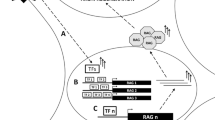Summary
Neuronal cells subjected to injuries such as trauma and hypoxia are destined to die. Using the motor nerve injury model, we collected and screened several genes associated with nerve injury. This gene screening suggested some molecular mechanisms that might contribute to nerve survival and regeneration after injury. Some of these molecular mechanisms are not seen in the central nervous system. This might be a reason why central nervous system neurons are particularly fragile. To compensate for the lack of gene expression in the injured neuron, use of an adenovirus vector is effective. Adenovirus mediated gene expression prevented injury-induced neuronal death and accelerated neurite elongation in vivo.
Access this chapter
Tax calculation will be finalised at checkout
Purchases are for personal use only
Preview
Unable to display preview. Download preview PDF.
Similar content being viewed by others
References
Pollin MM, McHanwell S, Slater CR (1991) The effect of age on motor neurone death following axotomy in the mouse. Development 112:83–89
Snider WD, Elliott JL, Yan Q (1992) Axotomy-induced neuronal death during development. J Neurobiol 23:1231–1246
Kiryu S, Yao GL, Morita N, et al (1995) Nerve injury enhances rat neuronal glutamate transporter expression: identification by differential display PCR. J Neurosci 15:7872–7878
Morita N, Kiryu S, Kiyama H (1996) p53 independent cyclin G expression in a group of mature neurons and its enhanced expression during nerve regeneration. J Neurosci 16:5961–5966
Nakagomi S, Kiryu-Seo S, Kimoto M, et al (1999) Dimethylarginine dimethylaminohydrolase (DDAH) as a nerve injury associated molecule: The mRNA localization in the rat brain and its coincident up-regulation with neuronal NO synthase (nNOS) in axotomized motor neurons. Eur J Neurosci 11:2160–2166
Tanabe K, Nakagomi S, Kiryu-Seo S, et al (1999) Expressed-sequence-tag approach to identify differentially expressed genes following peripheral nerve axotomy. Mol Brain Res 64:34–40
Kiryu-Seo S, Sasaki M, Yokohama H, et al (2000) Damage induced neuronal endopeptidase (DINE) is a unique metallopeptidase expressed in response to neuronal damage and activates superoxide scavengers. Proc Natl Acad Sci USA 97: 4345–4350
Namikawa K, Honma M, Abe K, et al (2000) Akt/Protein kinase B prevents injury-induced motor neuron death and accelerates axonal regeneration. J Neurosci 20: 2875–2886
Hirota H, Kiyama H, Kishimoto T, et al (1996) Accelelated nerve regeneration in mice by upregulated expression of IL-6 and IL-6 receptor after trauma. J Exp Med 183:2627–2634
Tanabe K, Tachibana T, Yamashita T, et al (2000) The small GTP-binding protein TC10 promotes growth cone-like formation and nerve elongation in neuronal cells, and its expression is induced during nerve regeneration in rats. J Neurosci 20:4138–4144
Author information
Authors and Affiliations
Editor information
Editors and Affiliations
Rights and permissions
Copyright information
© 2002 Springer-Verlag Tokyo
About this chapter
Cite this chapter
Kiyama, H., Kiryu-Seo, S., Namikawa, K. (2002). Gene expression and manipulation in injured neurons. In: Kikuchi, H. (eds) Strategic Medical Science Against Brain Attack. Springer, Tokyo. https://doi.org/10.1007/978-4-431-68430-5_8
Download citation
DOI: https://doi.org/10.1007/978-4-431-68430-5_8
Publisher Name: Springer, Tokyo
Print ISBN: 978-4-431-68432-9
Online ISBN: 978-4-431-68430-5
eBook Packages: Springer Book Archive




